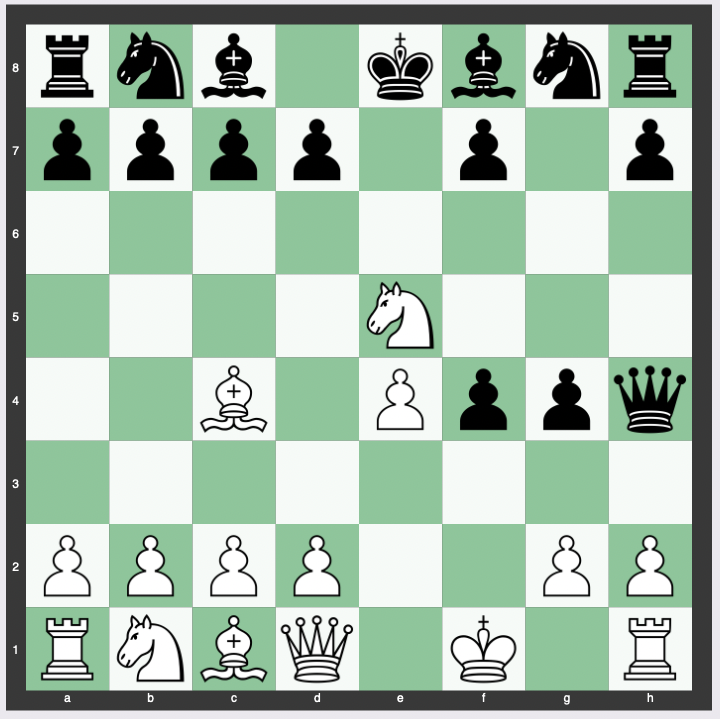The Salvio Gambit is a daring and aggressive move in the King’s Gambit Accepted that aims to rapidly develop White’s pieces and attack the Black king.
This opening is not as common as others in high-level games, but it brings an exciting element of surprise and tactical complexity.
Move Order of the Salvio Gambit
The move order of the Salvio Gambit is:
1. e4 e5 2. f4 exf4 3. Nf3 g5 4. Bc4 g4 5. Ne5 Qh4+ 6. Kf1

Position and Continuation
As mentioned, this particular gambit arises from the King’s Gambit Accepted line after 4.Bc4 g4 5.Ne5 Qh4+ 6.Kf1.
It is worth noting that the Salvio Gambit leaves the White King vulnerable due to the absence of a castling opportunity, which becomes a crucial part of the gameplay.
Comparison with Other Gambits
The Salvio Gambit is often compared with other gambits such as the Muzio, the Ghulam Kassim, and the McDonnell Gambits, all of which are characterized by aggressive lines.
However, these gambits offer white a potentially stronger attacking position compared to the Salvio Gambit, which trades off material for uncertain attacking prospects.
Potential Responses to the Salvio Gambit
Following the Salvio Gambit, Black has a few potential responses.
Silberschmidt Variation (6…Nh6)
The Silberschmidt Variation (6…Nh6) allows Black to play safely.
Cochrane Gambit (6…f3) and Viennese Variation (6…Nc6)
The Cochrane Gambit (6…f3) and the Viennese Variation (6…Nc6) present Black with counter-sacrifice options.
These responses lead to interesting dynamics in the game, adding an extra layer of complexity.
Evaluation of the Salvio Gambit
The Salvio Gambit is generally evaluated at around -1.70 to -2.10 for white.
Same continuation lines include:
6… Nc6 7. d4 Nxe5 8. dxe5 f3 9. Bf4 b5 10. Bxb5 Bc5 11. Qd2 Ne7 12. Nc3 c6 13. Na4 fxg2+ 14. Qxg2 Bd4 15. Be2 Ng6 16. Bg3 Qh6 17. Rd1 Nf4 18. Bxf4 Qxf4+ 19. Ke1 Bxe5 20. Qxg4 Qh6 21. c3 Rb8 22. Qh5 Qxh5 23. Bxh5
6… Nc6 7. d4 Nxe5 8. dxe5 f3 9. Bf4 b5 10. Bxb5 Bc5 11. Qd2 Ne7 12. Bg3 fxg2+ 13. Qxg2 Qg5 14. Qd2 Be3 15. Qc3 Bb7 16. Qd3 O-O-O 17. Ke2 Bb6 18. a4 h5 19. a5 Bc5 20. Rf1 h4 21. Bf4 Qh5 22. Ba6
6… Nc6 7. d4 Nxe5 8. dxe5 f3 9. Bf4 b5 10. Bxb5 Rb8 11. Nc3 Bc5 12. Qd2 Ne7 13. Bg3 fxg2+ 14. Qxg2 Qg5 15. Rd1 h5 16. h4 gxh3 17. Qxh3 c6 18. e6 d6
Conclusion: The Place of Salvio Gambit in Modern Chess
In conclusion, the Salvio Gambit, while not as popular as other openings in modern chess, offers a compelling blend of tactical complexity and surprise.
It is a testament to the beautiful intricacy of chess, and a reminder that even in the face of vulnerability, there may be a daring strategy waiting to be deployed.
Understanding and mastering this opening can provide players with a unique edge in their chess arsenal.
However, due to the risky nature of the gambit, it must be played with caution and a deep understanding of the subsequent positions and potential responses from the opponent.


